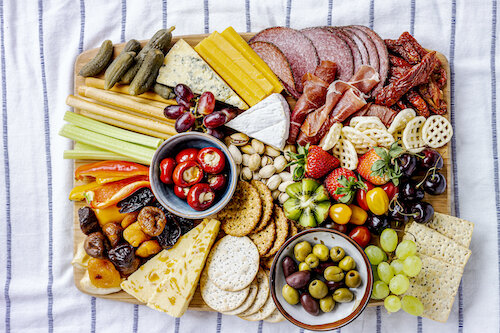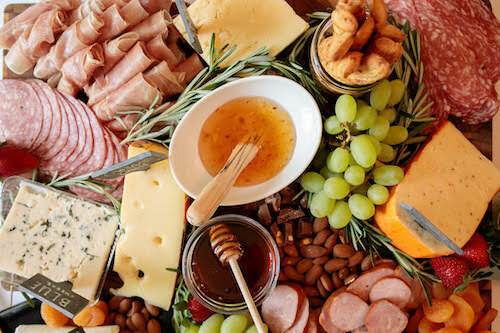3 Reasons Why it's Time to Stop the Cheese Board Madness
Editor’s note: Jam packed cheese boards are everywhere and they are impressive to look at, but are they actually a good idea? We tapped contributor Carol Penn-Romine to weigh in.
Food photo created by rawpixel.com
You’ve seen them: Cheeseboards so overloaded with goodies that you can’t tell what color the board is or whether it’s made of ceramic, glass or wood. They’re a riot of color, shape and texture and quite the feast for the eyes. Emboldened by all those Pinterest and Instagram pics, perhaps you’ve even dallied with the idea of fashioning one for your next party. Of creating a cheeseboard so lavish that it puts all those social media overachievers to shame. A stunning drop-the-mic contribution to the evolution of the cheeseboard.
But then think of all those outrageous outfits you’ve seen models wear on the catwalk. Sure, they’re eye catching, but you look at them, wag your head and think, “Who in blue blazes would wear that ridiculous thing? And where would they even wear it?”
"Charcuterie Board" by monpetitchouphotography is licensed under CC BY 2.0
Now, lump those photos of over-the-top cheeseboards into the same category, The Realm of the Grossly Overdone. Social media sites are bursting with photos of cheeseboards laden with enough cheese and assorted comestibles to feed the Viking hordes. While visually appealing, these cheeseboards aren’t really practical for a party or buffet. In fact, when it comes to partaking, they can be quite off putting.
Why?
1. They’re overwhelming
Put too much on one serving platter and guests pause, lost in the options. This slows up the line of hungry people behind them. One look at such a cheeseboard and I freeze in indecision. And if I decide to go with the one-bite-of-everything option, it still slows things down. I can feel the eye daggers in the back of my head as I hold up the line.
2. They’re impractical
Unless your tabletop is no larger than your cheeseboard, why overwork one serving piece? While such a board speaks of bounty, it makes the rest of the table look spare.
3. They’re germ pits
That wedge of gouda situated in the middle of a scattering of nuts and crudité looks mighty tempting, but when you cut a piece for yourself, you’re likely to bring your knuckles or shirt sleeves right down into it all, which is both messy and unsanitary. If I saw the guy in front of me drag his Bvlgari cufflinks through the quince paste, I’d give the entire board a pass. And unless you have tiny forks, picks, tongs and other utensils for plucking accompaniments out of the pack, it’s difficult to keep from making contact with food you don’t plan to eat—just as it was for the guests who got to it before you did.
When putting together a cheeseboard, resist the urge to go on eye appeal alone. Think about page composition in a magazine—the negative space is as important as the space filled with photos and blocks of copy. The eyes get fatigued when there’s too much to take in. So rather than resorting to the throw-on-some-of-everything philosophy of cheeseboard construction, make a plan:
Esters Cheese Board photo credit Elise Freimuth RC Family
1. Before deciding how many cheeses to include, consider how many people you’re serving and whether this is a light nosh or something more substantial. Odd numbers work best visually, so select three or five (of course no one will call the law on you if you select four!). Roughly plan on four ounces of cheese per person and round up for good measure. It’s better to have too much than too little. When you shop for cheese for a party, go into the store with a plan—and after you’ve eaten.
2. If the store has a dedicated cheese counter staffed with cheesemongers, solicit their advice. They have a wealth of knowledge and are eager to help you select just the right cheeses and put together the perfect combinations.
3. Think about what goes with each cheese and include that next to it. You wouldn’t park the gravy next to the fruit salad on the Thanksgiving feasting board, so likewise arrange items together that go together, like bleu cheese and dried fruit or shavings of parm with honey (salt brings out the sweetness, so these accompany each other beautifully).
cheese board featuring Caves of Faribault cheese courtesy Faribault Chamber of Commerce.
4. Preslice and precut the cheeses, so you don’t need as much room around them on the board for maneuvering with a cutting utensil. If you find the esthetics of wedges, rounds and bricks of cheese irresistible, situate those large, uncut pieces on the edges of the board. This way guests have room to cut them without mess or contamination.
Nettle Meadow Kunik photo credit Antonelli’s
5. If your spread is quite substantial, consider using several smaller boards, each dedicated to a single cheese and its accompaniments. This allows every cheese to be the star on its own stage and makes it easier for guests to graze and to know which accompaniments go best with each cheese.





